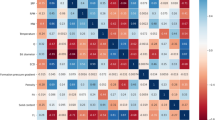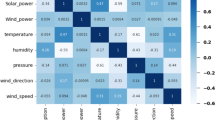Abstract
Accurate ship fuel consumption prediction is vital for the shipping industry. In this study, a stacking ensemble learning is developed to predict tanker fuel consumption precisely, built on cross-training of the first-level learner. Among comparative experiments, stacking with Bayesian regression (BR) as the meta-learner and extremely randomized trees (ET), gradient boosting decision tree (GBDT) and light gradient boosting machine (LGBM) as firstlevel learners achieves superior performance, yielding the best results. The root mean square error (RMSE) on the test dataset is 0.2679, and on the training dataset is 0.1327. Ensemble model-based feature importance analysis reveals that ship attributes (speed, draught, trim) contribute around 80 %, while meteorological features contribute about 20 %.
Similar content being viewed by others
Abbreviations
- BR :
-
Bayesian regression
- ET :
-
Extremely randomized trees
- GBDT :
-
Gradient boosting decision tree
- LGBM :
-
Light gradient boosting machine
- RMSE :
-
Root mean square error
- IMO :
-
International Maritime Organization
- ML :
-
Machine learning
- MLR :
-
Multiple linear regression
- RR :
-
Ridge regression
- ANN :
-
Artificial neural network
- SVM :
-
Support vector machine
- DT :
-
Decision tree
- KNN :
-
K-nearest neighbor
- RF :
-
Random forest
- AB :
-
Adaptive boosting
- TPE :
-
Tree-structured parzen
- XGB :
-
Extreme gradient boosting
- R 2 :
-
R square
- EI :
-
Expected incremental
- GC :
-
Golden creation
References
C. Dere and C. Deniz, Load optimization of central cooling system pumps of a container ship for the slow steaming conditions to enhance the energy efficiency, Journal of Cleaner Production, 222 (2019) 206–217.
UN, Review of Maritime Transport, United Nations Publications, New York, USA (2021).
IMO, Fourth Greenhouse Gas Study 2020, IMO, https://www.imo.org/en/OurWork/Environment/Pages/Fourth-IMO-Greenhouse-Gas-Study-2020.aspx.
Q. Meng, Y. Zhang and M. Xu, Viability of transarctic shipping routes: A literature review from the navigational and commercial perspectives, Maritime Policy and Management, 44(1) (2017) 16–41.
R. Adland et al., Does fuel efficiency pay? Empirical evidence from the drybulk timecharter market revisited, Transportation Research Part A: Policy and Practice, 95 (2017) 1–12.
Y. Du et al., Two-phase optimal solutions for ship speed and trim optimization over a voyage using voyage report data, Transportation Research Part B: Methodological, 122 (2019) 88–114.
Y. Du et al., Data fusion and machine learning for ship fuel efficiency modeling: part II - voyage report data, AIS data and meteorological data, Communications in Transportation Research, 2 (2022) 100073.
O. Sagi and L. Rokach, Ensemble learning: A survey, WIREs Data Mining and Knowledge Discovery, 8(4) (2018) e1249.
D. Berrar, Cross-validation, Encyclopedia of Bioinformatics and Computational Biology, Elsevier, 1 (2018) 542–545.
F. Hutter, L. Kotthoff and J. Vanschoren (eds), Automated Machine Learning: Methods, Systems, Challenges, Springer International Publishing, Cham (2019).
B. Shahriari et al., Taking the human out of the loop: A review of bayesian optimization, Proceedings of the IEEE, 104(1) (2016) 148–175.
M. Simonsen, H. J. Walnum and S. Gössling, Model for estimation of fuel consumption of cruise ships, Energies, 11(5) (2018) 1059.
O. Soner, E. Akyuz and M. Celik, Statistical modelling of ship operational performance monitoring problem, J. Mar. Sci. Technol., 24(2) (2019) 543–552.
Y.-R. Kim, M. Jung and J.-B. Park, Development of a fuel consumption prediction model based on machine learning using ship in-service data, Journal of Marine Science and Engineering, 9(2) (2021) 137.
Y. B. A. Farag and A. I. Ölçer, The development of a ship performance model in varying operating conditions based on ANN and regression techniques, Ocean Engineering, 198 (2020) 106972.
M. Jeon et al., Prediction of ship fuel consumption by using an artificial neural network, J. Mech. Sci. Technol., 32(12) (2018) 5785–5796.
T. Uyanık, Ç. Karatuğ and Y. Arslanoğlu, Machine learning approach to ship fuel consumption: A case of container vessel, Transportation Research Part D: Transport and Environment, 84 (2020) 102389.
X. Dong et al., A survey on ensemble learning, Front. Comput. Sci., 14(2) (2020) 241–258.
I. Ullah et al., Electric vehicle energy consumption prediction using stacked generalization: an ensemble learning approach, International Journal of Green Energy, 18(9) (2021) 896–909.
Z. Hu et al., A two-step strategy for fuel consumption prediction and optimization of ocean-going ships, Ocean Engineering, 249 (2022) 110904.
S. Cui et al., A stacking-based ensemble learning method for earthquake casualty prediction, Applied Soft Computing, 101 (2021) 107038.
M. H. D. M. Ribeiro et al., Efficient bootstrap stacking ensemble learning model applied to wind power generation forecasting, International Journal of Electrical Power and Energy Systems, 136 (2022) 107712.
Q. Li and Z. Song, Prediction of compressive strength of rice husk ash concrete based on stacking ensemble learning model, Journal of Cleaner Production, 382 (2023) 135279.
C. M. Bishop, Pattern Recognition and Machine Learning, Springer (2006).
L. Breiman, Random forests, Machine Learning, 45(1) (2001) 5–32.
P. Geurts, D. Ernst and L. Wehenkel, Extremely randomized trees, Mach Learn, 63(1) (2006) 3–42.
C. M. Bishop and N. M. Nasrabadi, Pattern Recognition and Machine Learning, Springer, New York, 4 (4) (2006).
J. H. Friedman, Greedy function approximation: A gradient boosting machine, The Annals of Statistics, 29(5) (2001) 1189–1232.
T. Chen and C. Guestrin, XGBoost: A scalable tree boosting system, Proceedings of the 22nd ACM SIGKDD International Conference on Knowledge Discovery and Data Mining, San Francisco, USA (2016) 785–794.
G. Ke et al., LightGBM: A highly efficient gradient boosting decision tree, Advances in Neural Information Processing Systems, Curran Associates, Inc. (2017).
Skitit-learn.org, Scikit-learn: Machine Learning in Phthon-Scikit-learn 122 Documentation, https://scikit-learn.org/stable/index.html.
XGBoost, XGBoost Documentation-XGBoost 174 Documentation, XGBoost, https://xgboost.readthedocs.io/en/stable/.
LightGBM, Welcome to LightGBM’s Documantation-LightGBM 33599 Documentation, LightGBM, https://lightgbm.readthedocs.io/en/latest/index.html.
C. Perlich, IBM Research Report: Learning Curves in Machine Learning, IBM (2009).
A. Singh, A comprehensive guide to ensemble learning (with Python codes), Analytics Vidhya (2018) https://www.analytics-vidhya.com/blog/2018/06/comprehensive-guide-for-ensemble-models/.
A. I. Naimi and L. B. Balzer, Stacked generalization: an introduction to super learning, Eur. J. Epidemiol., 33(5) (2018) 459–464.
P. Liashchynskyi and P. Liashchynskyi, Grid search, random search, genetic algorithm: A big comparison for NAS, arXiv: 192.06059 (2019).
J. Snoek, H. Larochelle and R. P. Adams, Practical bayesian optimization of machine learning algorithms, arXiv:1206.2944 (2012).
A. H. Victoria and G. Maragatham, Automatic tuning of hyperparameters using Bayesian optimization, Evolving Systems, 12(1) (2021) 217–223.
L. Breiman, Classification and Regression Trees, Routledge, New York (2017).
Y. Freund and R. E. Schapire, A decision-theoretic generali zation of on-line learning and an application to boosting, Journal of Computer and System Sciences, 55(1) (1997) 119–139.
C. M. Bishop and M. E. Tipping, Bayesian regression and classification, J. A. K. Suykens, I. Horvath, S. Basu, C. Micchelli and JV (eds.), Advances in Learning Theory: Methods, Models and Applications. NATO Science Series, III: Computer and Systems Sciences, IOS Press, 190 (2003) 267–285.
H. Hersbach et al., ERA5 Hourly Data on Single Levels from 1959 to Present, Copernicus Climate Change Service (C3S) Climate Data Store (CDS) (2018).
ECMWF, ORAS5 Global Ocean Reanalysis Monthly Data from 1958 to Present, Copernicus Climate Change Service (C3S) Climate Data Store (CDS) (2021).
M. H. Rio et al., Beyond GOCE for the ocean circulation estimate: synergetic use of altimetry, gravimetry, and in situ data provides new insight into geostrophic and Ekman currents, Geophys. Res. Lett., 41(24) (2014) 8918–8925.
Acknowledgments
This work is supported by the National Social Science Fund (21BGJ073) of China.
Author information
Authors and Affiliations
Corresponding author
Additional information
Mengjie Ma is a graduate student of the College of Transportation Engineering, Dalian Maritime University, Dalian, Liaoning, China. His research interests include green and intelligent transportation, machine learning, data mining and operational research.
Zhuo Sun is a Professor at the Department of Logistics in Dalian Maritime University. His research interests are in the areas of shipping network design and port planning. He developed a spatial planning tool named MicroCity (https://microcity.github.io).
Peixiu Han is a doctoral student of the College of Transportation Engineering, Dalian Maritime University, Dalian, Liaoning, China. Her research interests include green and intelligent transportation, machine learning, data mining and operational research.
Huirong Yang is a graduate student of the College of Transportation Engineering, Dalian Maritime University, Dalian, Liaoning, China. Her research interests include green and intelligent transportation, machine learning, data mining and operational research.
Rights and permissions
About this article
Cite this article
Ma, M., Sun, Z., Han, P. et al. A stacking ensemble learning for ship fuel consumption prediction under cross-training. J Mech Sci Technol 38, 299–308 (2024). https://doi.org/10.1007/s12206-023-1224-9
Received:
Revised:
Accepted:
Published:
Issue Date:
DOI: https://doi.org/10.1007/s12206-023-1224-9




